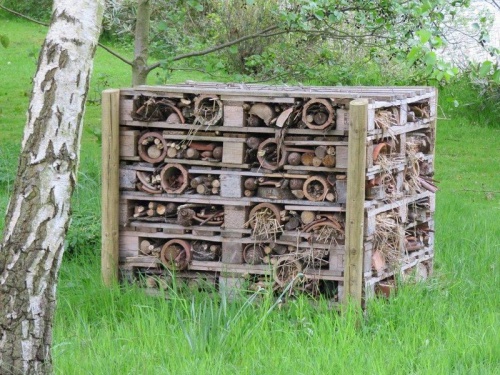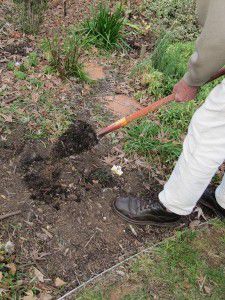COLEOPTERA is an order of insects that includes ladybirds and other beetles.
While not knowing too much about this subject, I understand there are about 30 orders of insects, but the largest groups are Coleoptera (beetles), Diptera (flies), Hymenoptera (bees, wasps and ants) and Lepidoptera (moths and butterflies).
All are under constant threat, particularly with the overuse of chemical sprays in the garden and the wider field of horticulture and agriculture. There is a vitally important role for such insects in the garden.

As the photo shows, what looks like a pile of broken objects and garden waste is a five-star, winter break hotel for insects, bugs and beetles. It provides food and shelter for all of the above listed insects. It is built using recyclable materials, most of which can be found in many gardens. It need not be as large as illustrated, but you get the idea.
If you are contemplating building a similar hotel it is not too late to enable insects to book in for the rest of winter. This also can be a learning experience for children about the wonderful world of insects and illustrates how beneficial the insects are for our environment.
Lunchtime lecture on Italian gardens
BEN Walcott is the next speaker at the Friends of the Australian Botanic Gardens lunchtime lectures at the theatrette, 12.30pm, on Thursday, July 25. He will speak on “Classic Italian Gardens and What They Can Teach Us About Design”. Entry is by gold-coin donation.
Compost: to dig or not to dig?
OKAY, so you have been emptying compost bins that have been quietly rotting away to make more room for leaves. Or you have a surplus of leaves starting to rot with the recent rain. Do you apply this organic compost material to the top of the ground or dig it in?

Let us look at the opposing forces, as suggested by the Royal Horticultural Society. Most gardeners are unsure which is the more beneficial.
The case for “digging” is that it ensures phosphorus and potassium released by the organic material remains at root depth. Sandy or light unstable soils (this advice is also applicable to the coast) can settle and become airless. Digging in compost counteracts this. Sowing or planting is easier if the soil is dug over. Digging can bury weed seedlings and allow easier removal of large weeds.
The case against “digging”, especially if the ground is wet, is that it often damages the soil structure and disturbs beneficial soil organisms, such as worms and mycorrhizal fungi, vital for any garden.
Digging means exposed earth loses valuable moisture when the weather warms up with evaporation and brings weed seeds to the surface where they will quickly germinate with exposure to light.
Personally, I recommend no digging. This also applies to mulching in spring with my favourite recycled, green-waste material, Canberra Sand and Gravel’s Canberra Organic Mulch. The worms revel in this material and in no time at all will turn it into the existing soil.
I HAVE received inquiries on pruning clematis. Now is the time to prune early-flowering clematis such as C. Montana rubens, C. Armandii, C. Alpina and C. macropetala can be cut back freely.
Use shears or secateurs to cut these back by a third. They will soon respond with new growth as soon as the weather warms. Next edition I will feature varieties of evergreen clematis that can be mixed with deciduous clematis so that you do not have a bare look all winter.
No excuses
WE have been having a run of beautiful winter days with hours of sunshine and no excuse for not getting into the garden so how about…
- Checking ground moisture. With little rain and frost, moisture is drawn from the soil.
- Dividing bearded iris, cutting off any damaged parts.
- Floating hellebore flowers in a bowl of water to enjoy indoors.
- Pruning grapevines. If left to spring, the new growth will bleed sap profusely.
Who can be trusted?
In a world of spin and confusion, there’s never been a more important time to support independent journalism in Canberra.
If you trust our work online and want to enforce the power of independent voices, I invite you to make a small contribution.
Every dollar of support is invested back into our journalism to help keep citynews.com.au strong and free.
Thank you,
Ian Meikle, editor




Leave a Reply